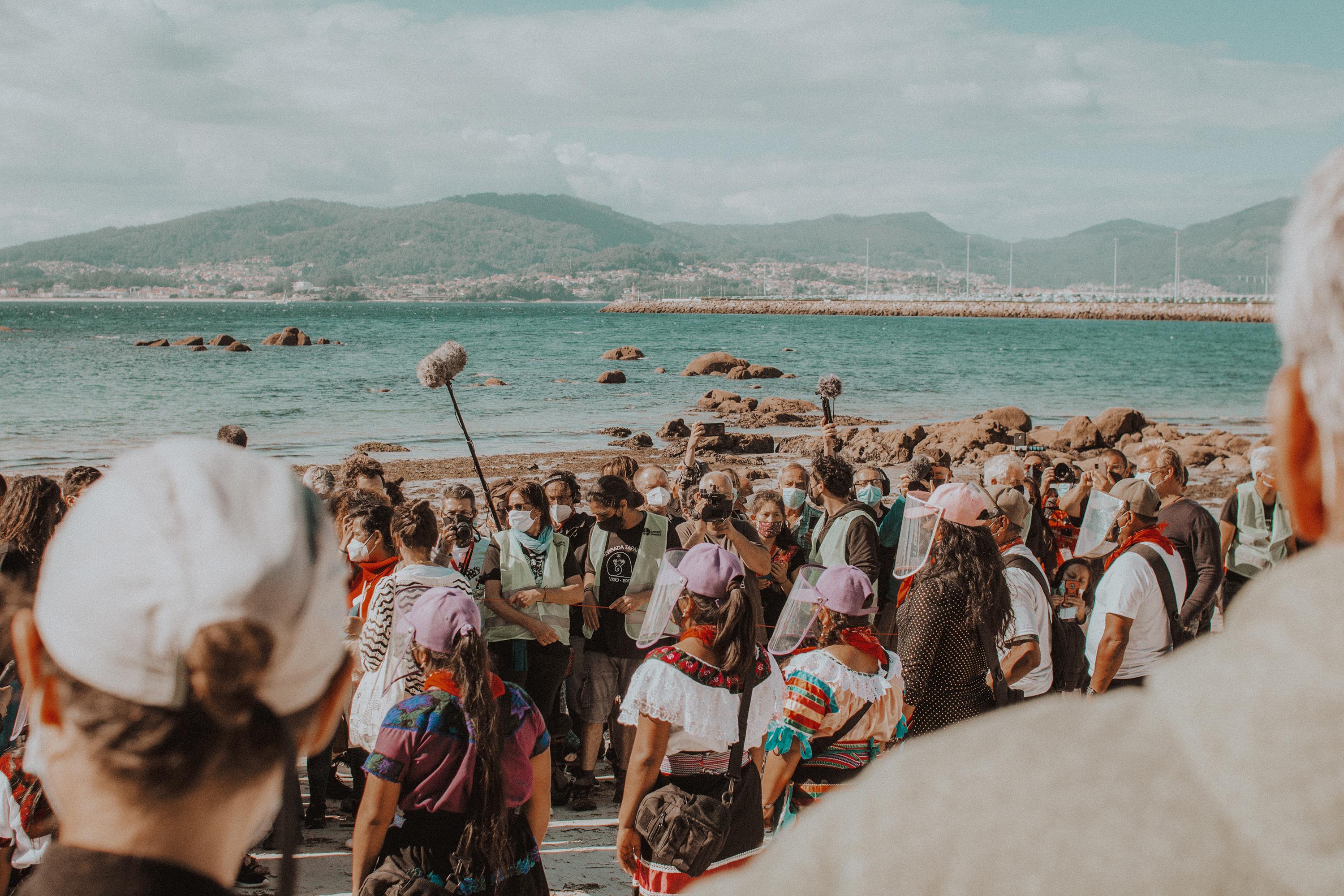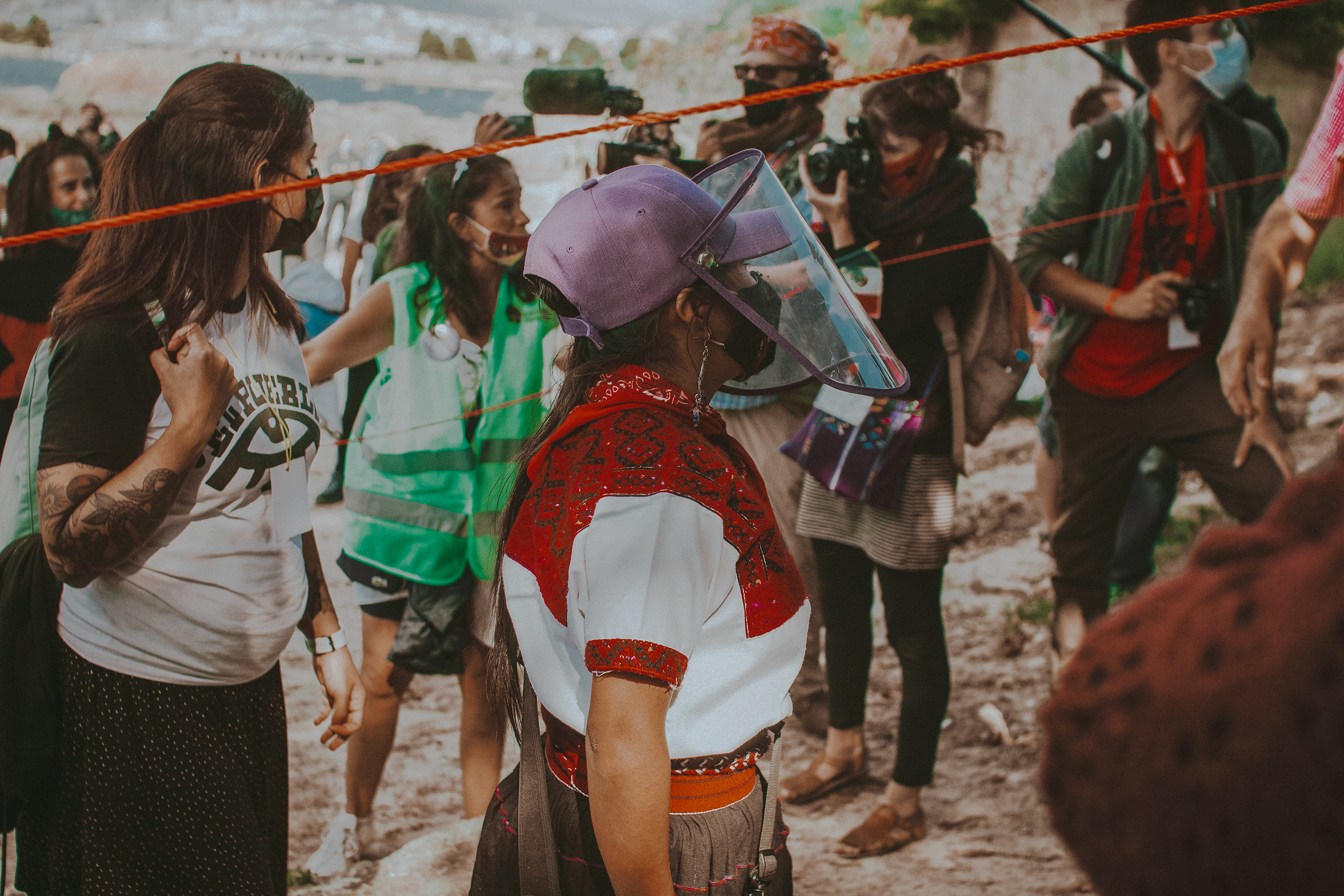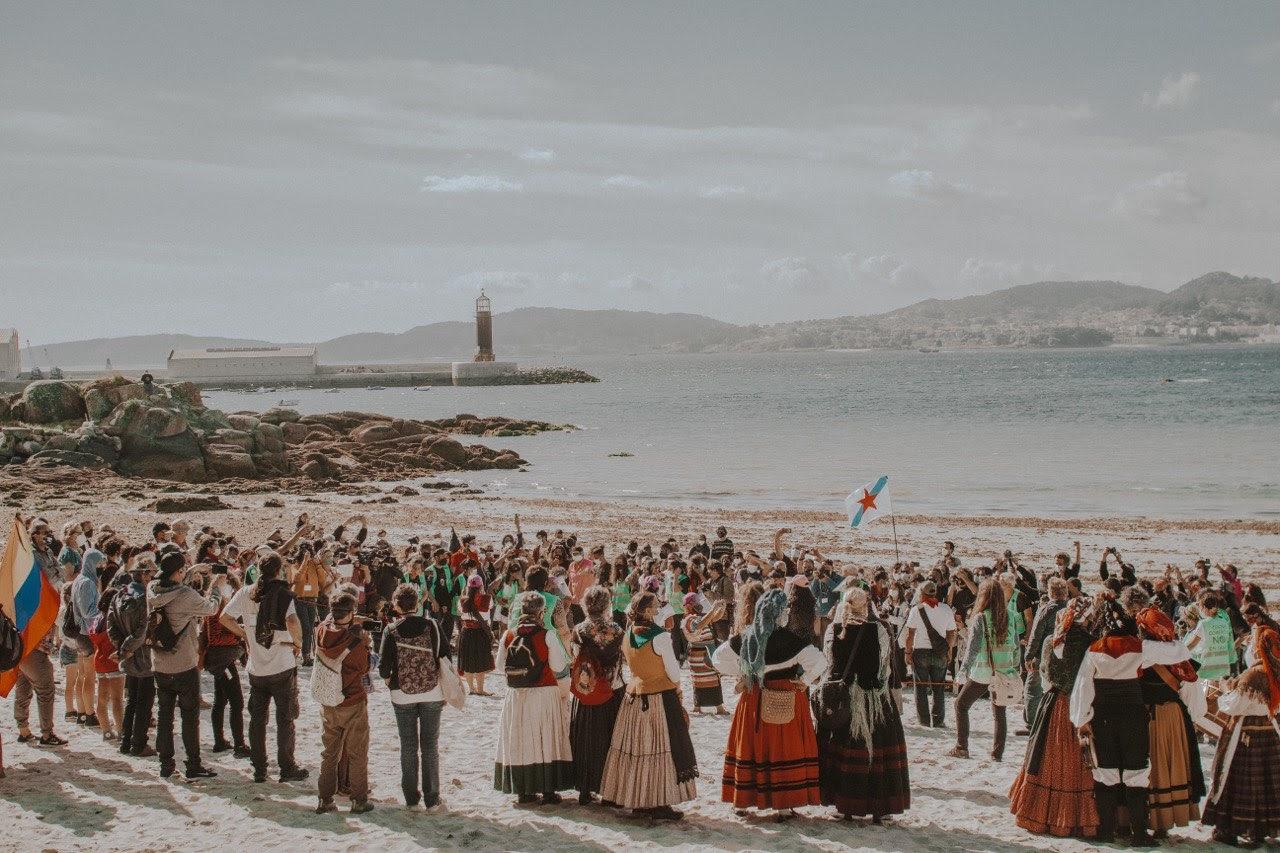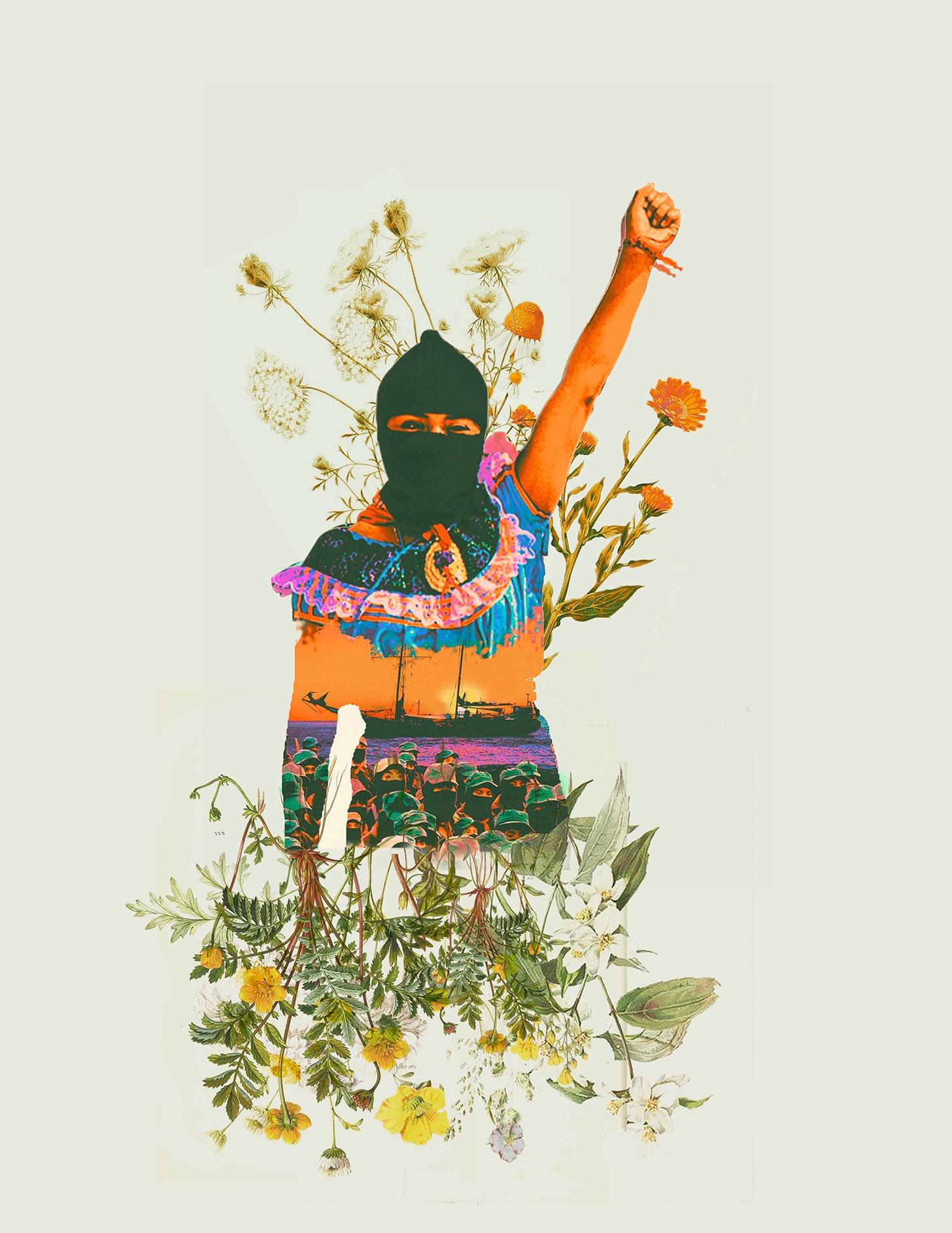taller ahuehuete, Lluvia Benjamin
Mirrors and Mirages in Slumil K’Ajxemk’op
An aura of mysticism envelops the appearance of the Zapatista insurgent movement

From Chiapas: Capital Is Seen With Lucidity
The Heads of the Hydra Hold the Mirror
“It’s not that what is past casts its light on what is present, or what is, present its light on the past; rather, image is that wherein what has been comes together in a flash with the now to form a constellation. ”
– Walter Benjamin, “Awakening” (Arcades, 462)
The Mirror
An aura of mysticism envelops the appearance of the Zapatista insurgent movement.
The exoticism towards the struggle of the autonomous indigenous people becomes palpable – almost visible – before the characteristic images that emerge from the caracoles generally disseminated and absorbed by the public without the textual mediation of the articles that accompany them.
They are then absorbed in the way the spectacle taught us to perceive the TV: static and two-dimensional, and rarely as dialectical images.
Nevertheless, pictorial analysis must surrender to the peculiar condition of the nature morte, for it is this way in which the average viewer takes it in. From an aesthetic scope, the contrast between the darkly-hued balaclavas juxtaposed with the vivid primary and secondary tones on the clothing of the Tsotsil, Tseltal and other originary peoples generates an almost morbid curiosity in the mind of the spectator, assuming that she is a participant in societies whose attire is dictated by the consumerism of the western capitalist system.
The crisp green (with shades of yellow-highlighter) of the Lacandon Jungle against the sensual photographs of red bandanas and bellicose artifacts captivate the observer, regardless of her political alignment.
Captivating an audience in an information-saturated society is thus worth appraising. After all – and supposing our common experience is that of a cybernaut in Western geographies – we might not be surprised to face the fact that the median amount of exposure to images with commercial content in the 1970s averaged between 500 and 1600, depending on population density. It is estimated that in 2021 the number of images we encounter ranges between 6,000 and 10,000 per day.
The precariat, whose presence is limited to the social margins, is perceived as not worthy of consideration[1] in today’s cultural landscape.
As writer and poet John Berger mentioned:
«The poverty of our century is unlike that of any other. It is not, as poverty was before, the result of natural scarcity, but of a set of priorities imposed upon the rest of the world by the rich.
Consequently, the modern poor are not pitied… but written off as trash.
The twentieth-century consumer economy has produced the first culture for which a beggar is a reminder of nothing.»
The presence of Zapatismo, with its visual contrasts and the exoticism to which it is subjected as a public response, is a flagrant contradiction because no revolutionary vernacular had foreseen an insurgent struggle with these attributes: devoid of affiliation to a declared political party, without explicit ideological affiliation as a banner, anti-identitarian but multifaceted [2], and above all not the product of a highly educated society (educated, according to the criteria of the hegemonic academic apparatus, i.e., by Western standards).
And as it occurs with events of a phantasmagoric character, the auratic effect exhibited gives light to a mixed mythology, and its discourse reflects how the human being filters the material world through ideology. The German writer T. W. Adorno mentioned that:
«Without a doubt, the commodity is the archetype [Urform] of ideology; however, the commodity itself is not simply a false consciousness, but is the result of the structure of Political Economy.»
Chiapas is categorized, commodified, conceptualized, and soon a mirror of the viewer’s tendentious position. But above all, Chiapas is perceived in relation to the class and empirical understanding of the subject, concerning one’s material experiential in the face of poverty, scarcity, and our cartography in the history of expropriation. Or, rather, the primitive mode of accumulation in Abya Yala.

From Chiapas: Capital Is Seen With Lucidity
The perplexity that accompanies the territory that declares itself as Mexico, since its synthesized debut as a nation-state in the face of the failed agrarian revolution (1910 — 1920) should not astonish us, for we can find in this “republic” some features not present in the quasi-homogeneous European society to which Marx was exposed.
The latifundium and hacienda models, which governed what we now know as the free and sovereign state of Chiapas, could not simply be distilled to private property, encomiendas, tributes to the caciques and campesino slave-labor. In this economic system, in this particular class struggle, other factors not present in the critique of political economy must be contemplated simultaneously. And these constellations are presently being dissected outside the academic apparatus. This type of analysis is predominant within the theoretical margins of the communiqués, and the accumulated body of literature generated by Zapatismo straight from the source.
Years worth of critical theory readily available online, and translated into multiple languages, await anyone with a drop of curiosity. It might impress a few – especially the many disconcerted-but-well-meaning, the clueless fellow-travelers – unaware of their entitlement and condescension, who frequently ask to interview a Zapatista for their podcast or reading group. Their desire to access the strangely hermetic ways of the insurgents reflects a reluctance to hear their collective voices.
The communiqués do not shy away from eloquent allusions to the dominant value-form and the preponderant bias from the mode of production towards the commodity by disregarding hindrances (from the perspective of capital) such as human life and nature.
This concurrent terminology in Zapatista communication would confuse the European of our previous paradigm — if he were to learn about it — for he would find the Zapatista voice contaminated by ‘Eurocentric’ Marxist ideology. When will he realize that this “exotic revolutionary experiment” is made up of conscious beings? Endowed with reason, they have reiterated over and over, and insisted again in June 2021[3]:
«It turns out that, also through studying and analyzing, we have discovered something that could be important, or not; it depends.
Taking it as a given that this planet will be annihilated, at least the form in which we currently perceive it, we have been researching the possible options.
Which is to say, we believe that we have established the identity of the criminal, their modus operandi, and the crime itself. Those three characteristics combine to form a system, or a way of relating with humanity and with nature: capitalism»
Or as documented in 2018, during “300, Part I: A Plantation, a World, a War, Slim Chances Subcomandante Insurgente Moisés, SupGaleano”:
«The system functions with this contradiction (among others): it wants to rid itself of the labor force because its “use” brings with it various problems (for example: it tends to organize, protest, strike, sabotage production, and join forces with other workers); but at the same time the system needs that “special” commodity to consume other commodities.
It’s not the existence of work that defines capitalism, but the characterization of the capacity to work as a commodity to be bought and sold on the labor market. That means there are those who buy and those who sell, and above all, those who have only the option of selling themselves.
The possibility to purchase labor power is provided for by private ownership of the means of production, circulation, and consumption.
Private ownership of the means of production forms the nucleus of the system.
Built upon this class division: the owner of private property and the dispossessed.
And hiding it as such, are a whole range of juridical and media simulations, as well as other dominant evidentiary forms: citizenship and juridical equality; the penal and police system; electoral democracy and entertainment (increasingly difficult to differentiate); neo-religions and the supposed neutrality of technology; social sciences and the arts; free access to the market and to consumption; and a whole spectrum of nonsense of things like “change begins within oneself”, “you are the architect of your own destiny”, “when life gives you lemons, make lemonade”, “don’t give fish to the hungry, teach them to fish” (“and sell them fishing poles!”).
And, highly fashionable today, efforts to “humanize” capitalism by making it good, rational, and objective, that is: capitalism light.»
And with his characteristic tendency to jest, Subcomandante Insurgente Galeano adds, so that there is no doubt as to the referential source:
«The system advances in its reconquest of the world without concern for what is destroyed, preserved, or made superfluous; anything is disposable as long as the maximum profit is obtained at maximum speed.
The machine is returning to the methods of its origins—that’s why we recommend you read The Primitive Accumulation of Capital—which is to conquer new territory via violence and war.»

The Heads of the Hydra Hold the Mirror
In Slumil K’Ajxemk’op, direct participation in Chiapas — that is, having previously visited the area — was a detail that escaped from the mouths of the interlocutors as if it were a job interview and one randomly mentioned having graduated from a prestigious institution.
Chiapas, during conversations initiated by those seeking a new and horizontal society, was often transformed into a sacrosanct symbol; a social medal, a trophy to quickly distinguish the international militant from the insurgent’s hierarchy. Chiapas was an emblem, a badge for the ranks of the average activist: that is, distinct from the provincial, regionalist, or awkwardly theoretical one whose presence lies at the bottom of the ‘non-existent’ pyramid of tendency.
The EZLN, which in Mexico is criticized as passé by the demographic body that claims to be conglomerated as “mestizo” (often an erroneous synonym for “Mexican citizen”), in Europe possesses different characteristics.
«A picture is worth a thousand words» it is suggested.
The emphasis on appearances should not surprise the reader. But what is known concretely about Zapatismo outside the political sphere? What is mediated externally if one does not absorb the Mexican discursive apparatus, which is the mouthpiece of the state and of capital, and which claims the movement’s irrelevance despite the fact that the Journey for Life has demonstrated the contrary in this odd land?
The EZLN, its orientation towards direct action, and its antagonistic position to the bloodthirsty State confuses the standard European. Atomization rules the societies at the core of capitalism. The mode of production is so far ingrained that the reproduction of this economic structure is not only limited to our labor force, to our null possession of the means of production, but our perception of the holistic reality as well, for this too is fetishized.
The unquenchable thirst for capital accumulation appears as the only need regarded as genuine, the sole priority and only magnitude of our societies. Aware of the valuable work done by bourgeois economics and liberal ideology to sustain its reign, capital discovered that promoting individuality would thus ensure its absolute triumph.
The subject, the free individual, the egalitarian citizen!
Or, rather, the best alibis used by the capitalist to hide our irrefutable class struggle. As in Marx’s time, production today is determined by the social conditions in which consumers find themselves, and these same conditions are rooted in class antagonism.
We are dismembered to the marrow: that is, we are nothing more than entities merely capable of selling our labor-power in a predefined manner for the benefit of the capitalist, who in turn converts our share into surplus-value.
This existential particularity, this shameful reality — or rather, identity — is our communal standardization: we share this characteristic, that is, we are sisters in deprivation. And in turn, this same homogenization of the working class compels our non-identification with the reason for our subjugation: wage labor, or a double dependence to it.
The words of Karl Marx in his 1844 Economic and Philosophical Manuscripts resonate like an echo still pertinent to our era:
«Political economy can therefore advance the proposition that the proletarian, the same as any horse, must get as much as will enable him to work.
It does not consider him when he is not working, as a human being.»
However, contrary to what was envisaged in orthodox Marxist theory and the optimism of the various workers’ movements, the position of the worker in relation to her exploitation has not been the emancipatory route, nor the necessary equation for the social exodus from the prison to which the value-form chained us. But as beardy reminds Kugelmann:
«The history of the world would indeed be very easy to make, if the struggle were carried on only on condition that opportunities were unfailingly favorable.»
The oppressed human being prefers to dispense of the characteristic that links her to the rest, choosing instead to define herself – or, as the spectacle would more aptly describe it, she prefers to express her identity in other ways.
As a commodity, the worker has thus been categorized in the most dehumanizing way. Multiple categories of atomization continue to emerge, turning us into infinite suffixes and prefixes.
If in the past the human being was defined and transformed by how she interacted with nature (that is, by the fruit of social activity: vital activity, work and interaction with her milieu), today the categories that emerge daily like mushrooms in the forest after the rain define us by the stratification we suffer, which is tangible and real and which, nevertheless, only reflects the multiple wounds from the hydra’s heads and not the actual wound inflicted holistically by the core.
This very reduction of our reality has produced categories that seem more real than the extant dominance of capital over our lives. Our perception ignores the material, which in turn ignores that it is this very structure that allows our daily, constant and suffocating subjugation [4].
«Capital can only increase by exchanging itself for labor power, engendering wage labor. And the labor power of the wage-laborer can only be exchanged for capital by increasing it, by strengthening the power of which it is the slave. The increase of capital is, therefore, increase of the proletariat, i.e., of the working class.»
The self-identification process also exists in left-wing movements, which see Chiapas from a distant perspective as a mirage. The continuous retelling of this mythology prevents a materialistic – and not an idealist – analysis of the situation that mobilizes Zapatismo.
The tyranny and despotism that subjected the originary nations for centuries was precisely the “enough is enough!” of their struggle. Subcomandante Moisés describes with an erudition difficult to find among the ranks of academics the intricacies of this primitive mode of accumulation. The Zapatistas suspected that it was true, that although they had not witnessed this incessantly hindered status, their struggle was rooted in the desire for a dignified life, a characteristic perpetually denied (which continues to be denied) to them. Their intuition told them that,
«to live is not only not to die, it is not to survive.
To live as human beings is to live with freedom. To live is art, is science, is joy, is dance, is struggle.»
The Zapatista Maritime Squadron 421 expressed it more concretely during their powerful speech on August 13th in commemoration of the 500 years of indigenous resistance to colonialism coinciding with the siege of Tenochtitlán:
«Then there is someone or something that prevents us from living, that snatches our freedom, that deceives us, that swindles us, that corners us, that takes the world away from each one of us with bites, with stabs, with wounds: capitalism.»
The “enough is enough!” of the originary people is transmitted through theory and practice, contemplation and struggle.
“Marx never renounced praxis,” admitted Theodor Adorno, “much less did he leave a manual with clear instructions.” He understood that the conditions of the people and the individual in pursuit of emancipation would be different in each terrain and nevertheless general, for subjugation was materially inflicted. In the words of the author Jasper Bernes[4]: You cannot unteach hunger. Adorno[5] put it this way:
«Praxis is a source of power for theory, but it cannot be prescribed by it.
It appears in theory simply, and indeed necessarily, as a blind spot, as an obsession with what is criticized.»

Keeping Our Eyes on the Heart (of the Hydra)
The critique of their material conditions, the Zapatista ”¡ya basta!” has taken a violent toll, as happens to revolutionary movements in search of communal autonomy: they become, from the beginning, a time bomb. Blood, corpses, casualties, sorrow, grief, tears, violence.
Capital and the State have declared themselves owners of everything and everyone. Our labor force is the only thing we possess, and it exacts a certain value. Our identity is this, what the mode of production has reduced us to. As beardy reminded Kugelmann:
«Once the interconnectedness is understood, any theoretical belief in the permanent necessity of the existing conditions collapses before its failure in practice.
Therefore, it is absolutely in the interest of the ruling classes to perpetuate a meaningless confusion.»
The identity movement, incorporated into the language of the hydra, thrives on obfuscation in our logic. In the words of SupGaleano on June 2021:
«According to the big Hollywood blockbusters, the way out of a global catastrophe (always something external: aliens, meteors, inexplicable pandemics, zombies […]) is for all the governments of the world to join together (headed by gringos).
Or, worse, for the United States’ government to be synthesized in an individual [un/a individuo/a] who has the politically-correct racial and gender characteristics but still wears on their chest the mark of the Hydra, because the machine has learned by now that the farce should be inclusive.»
And since our existence is summed up – according to the present mode of production – only to our labor force for sale in the labor market in exchange for survival (“cost of living”), and this corresponds to a numerical sum, everything can be bought in the eyes of the capitalist.
“Everything and everyone has a price,” scoffs the capitalist, without comprehending that this is not a deontological defect, nor a tragedy intrinsic to human nature, but the result of the total vulnerability and dull compulsion to which the system subject us.

As Subcomandante Insurgente Moisés states in his illustrative exposition of the trajectory made from the period of primitive accumulation of capital in the finca system to our present day, in “The capitalist world is a walled plantation” (April 12, 2017):
«In capitalism there are no countries, that’s how we see it.
Capitalism is going to turn the whole world into a plantation [...] because the one who rules is no longer the one who rules. The capitalist boss is the one in charge. [...] The governors are the overseers.
The municipal presidents are the gaffers.
All of them act in the service of capitalism.
This means that the master, capitalism, is going to turn the whole world into its hacienda, that is, if we allow it.
Our question there as Zapatistas is: why do they – the capitalists – get to change their mode of exploitation? And why don’t we change our form of fighting to save ourselves from that outcome?»

The German dreamer and philosopher Walter Benjamin declared that «the tradition of the oppressed teaches us that the ‘state of emergency’ in which we live is not the exception but the rule.»
The violence inflicted daily on Zapatista communities does not reach the ears of those who glorify the movement until a communiqué explicitly expresses the urgency of a larger manifestation of cross-cultural solidarity (Chiapas al Borde de la Guerra Civil, Enlace Zapatista, 2021), as they consider Zapatismo a concluded, finished and victorious concept. They perceive it, after all, in the same way as the multiple identities contrary to the status quo they adjudicate to themselves: a succinct narration of their fetishized existences, an appearance. Zapatismo in Slumil K’Ajxemk’op is often reduced to this: an exception to the rule, a hypnotic and victorious experiment. A mirage of insurrection at a distance.
There is reticence in Slumil K’Ajxemk’op. The sensual images of the insurgent movement (“anarchist! anti-state! anti-capitalist! communist!”, as they try to define it under their familiar categorizations) are soporific for the European nonconformist. The dream of critical reason, which produces monsters unwilling to conduct a proper assessment of our material conditions, takes hold of these anti-systemic figures. Their revolutionary dichotomy allows only one duality: barricade or trench, occupation or liberation, revolution or reform, victory or defeat.
In the face of the multiple paramilitary interventions within the Autonomous Municipality of Lucio Cabañas, and the harassment of the paramilitary group “Los 40”, the ears of the defiant in Slumil K’Ajxemk’op are muffled.
The murder of Simón Pedro in broad daylight, that is, the deathly shot in the head that the member of the pacifist civil organization “Las Abejas de Acteal” received in front of his son did not reach the ears of the insubordinate. It was one more statistic, another headline to overlook.
Before the constant threats and disappearances reported by the FRAYBA, or before those met without punishment that the networks of resistance and rebellion describe in their summons for solidarity, the audience in Slumil K’Ajxemk’op seems disturbed, incapable of processing this information until it is emphasized in the most direct way; they appear detached because Zapatismo represents a concluded project, a strange one, but concluded. An odd, but a triumphant movement. A historical exception.
«A historical exception that can only manifest itself in the jungle, far away, and not here in civilization.
Zapatismo cannot be reproduced here, in normal society…»
In normal society. This adjective – an ad verbum quote heard in Slumil K’Ajxemk’op – describes the person expressing it more than the entity it is intended to denote.
In light of this, in their epistolary exchange regarding aesthetics (and politics, I would previously have said, but it would be redundant. All aesthetics is political, even that which is self-described as “apolitical,” meaning reactionary) the late Subcomandante Insurgente Marcos remarked from the mountains of the Mexican southeast to John Berger:
«”This does not happen here,” says the reader’s vision of the photo, “that is Chiapas, Mexico, a remediable, surmountable historical accident, and... far away”.
There are also other readings that confirm this: advertisements, financial figures, stability, peace.
That is the purpose of the indigenous war at the end of the century, to revalorize peace. Just as a stain highlights the target that suffers it.
“I am here and this photo takes place in another place, far away…” says the “reading” that distances itself.»
The Journey for Life has as its purpose the dialogue and the weaving of struggles on the margins of society between the multiple narratives and afflictions that oppress us. The travelers from Chiapas understand the multiplicity of pains on earth that we experience as our own. They understand, as they clearly stated, that:
«We are differentiated and distanced by lands, skies, mountains, valleys, steppes, jungles […] lagoons, races, cultures, languages, histories, ages, geographies, sexual and non-sexual identities, roots, borders…»
The Zapatista communities come to Slumil K’Ajxemk’op to listen, to dialogue, but above all to listen. Not in an anthropological mode reversed, with the object of study (the dehumanized noble savage that delighted and continues to delight the field) now interviewing the interviewee, for the project lacks that vindictive quality. But why? It is not a question of mobilizing on the basis of what separates us: executioner and victim, or exploited proletariat versus capitalist, as the rhetoric of the workers’ movements of the last century tried and failed to do.
This strategy remains embedded in the capitalist narrative, subjugated to the value form, still functioning within it. Zapatismo proposes something different, but not by contesting the axiom that history is written by class struggle. No, it maintains that principle above all else: the heart of the capitalist hydra is the target.
It reiterates the question in a different form. The strongest incentive toward mobilizing, the Zapatistas argue, is not that of our palpable subjugation, the class struggle we experience daily, or exploitation as the norm. Through a model of constellations, they prompt us to ask ourselves – understanding that the question is not addressed to a homogeneous audience – “what would life be like if another world were possible? And why isn’t it?”
Subcomandante Moisés’ words resonate like the constellation-form of Benjamin (The art that is neither seen nor heard. July 29, 2016):
«Each person must struggle, and we must support each other, but that support cannot substitute for each other’s struggle.
Whoever struggles has the right to decide the direction of his path and with whom he travels it.
If others insert themselves, then they are no longer supporting that struggle, but supplanting it.
To support is to respect, not to try to direct or command [...] No one is going to liberate us but ourselves.»
Mobilize ourselves, then, by the potentiality of the many worlds we may create. Can we even envision what a more tender and logical vision than the lust for surplus-value extraction would look like? In the face of an unquenchable thirst for capital, life. In the face of exploitation, the search for paths to dignity for all. In the face of injustice, dignified rage, that is, strategic mobilizing by sentipensar[6]: praxis based, as Adorno just mentioned a few paragraphs ago, on the rage that is born naturally, through critical observation, as a result or “as an obsession of what is criticized.”
The Echo of Benjamin: The Tradition of the Oppressed
The past century has shown us that it is impossible to organize solely on the basis of our position in the mode of production; that is, as exploited members of the working class without volition. According to the analysis of contemporary thinkers Aaron Benanav and John Clegg[7]:
«The domination of capital over labor was reinforced in the organization and arrangement of factory production.
In fact, capitalists were able to take the divisions running through the labor market and import them.
Workers remained divided in terms of gender, language, religion and regional customs.
To these differences were added new ones: race and nationality, as well as the emerging and constantly changing hierarchies of skills and education.
In this sense, workers’ unity remained, for the most part, a unity in separation: it was a unity mediated by capital; it was therefore unavailable as a ready weapon in the struggle for emancipation from capital.»
The indigenous nations affiliated with the EZLN admit that spatial-territorial solidarity is possible, indeed necessary in spite of our differences, because it is “the understanding that it is a system that is responsible for these pains” by which we could be united.
«The executioner is an exploitative, patriarchal, pyramidal, racist, thieving and criminal system: capitalism. It is the awareness that it is not possible to reform this system, to educate it, to attenuate it, to iron it out, to domesticate it, to humanize it.»
Benjamin’s words are present as an echo. He is not wrong[8], the tradition of the oppressed teaches us that the “state of exception” in which we live is but the rule.
The Zapatistas recognize that, despite having expropriated the land from the caciques, the hacienda owners and the State (“the land is of those who work it”), this expropriation is conditioned and subjected to the threat of continued violence.
Their existence and autonomous social functioning represents a challenge to the mode of production and, therefore, must be exterminated. The threat does not end with the success of emancipated territory from the clutches of capital. Terror and violence are still prevalent even after an autonomous triumph with respect to the state, and the various participatory and more egalitarian economies in a communal setting.
The victory over the hydra is not freedom from the worker-machine-factory triad, nor the cessation of the state of exploitation. Communization over private property, solidarity over individualism, dignity over exploitation, comradeship over indifference, life over profit must be radically disseminated, that is to say, our mission is to truly extirpate the poisonous weed from the root. Abolish the value-form, understanding its elusive tendency to reemerge under different names, by realizing that its appearance is but a continual metamorphosis.
The land that refuses to give up must abolish its myopic boundaries in theory and practice. Or all the spatial pockets – that anthropologists and academics use as exceptions to the rule – will be reclaimed sooner or later. As Marx reminds us, if money “comes into the world with a congenital blood-stain on one cheek,” capital comes dripping from head to foot, from every pore, with blood and dirt[9].
The call issued in Slumil K’Ajxemk’op to choose life and dignity for all (“in the face of big capital, a common cornfield”) must be heard on the entire (and overheating) surface of the earth.
The weaving of global solidarity is the only rope that will bring us closer to the lifeline. Otherwise, the gallows will be woven in its place, tied around Mother Nature’s neck. And with this sentence, our extinction at last.
We do not have much time left.
«The survival of humanity depends on the destruction of capitalism.» (Enlace Zapatista)

[1] from Latin considerare “to look at closely, observe,” probably literally “to observe the stars.”
[2] González Casanova, Pablo. Sociología de la explotación. CLACSO, Consejo Latinoamericano de Ciencias Sociales, Buenos Aires, Argentina. 2006.
[3] Enlace Zapatista.
[4] Adorno, Theodor W. Marginalia to Theory and Praxis.
[4] Adorno, Theodor W. Marginalia to Theory and Praxis.
[5] Bernes, Jasper, Revolutionary Motives , Endnotes 5: The Passions and the Interests.
[6] Galeano, Eduardo (1993–2012) The Book of Embraces . Madrid: Siglo XXI.
[7] Benanav, Aaron. “Crisis and Immiseration: Critical Theory Today” (with John Clegg), in The SAGE Handbook of Frankfurt School Critical Theory, eds. Werner Bonefeld, et. al., New York, Sage Publications, 2018.
[8] Benjamin, Walter. * On the Concept of History*, (often referred to as Theses on the Philosophy of History).
[9] Marx, Karl. Capital Volume One, Chapter Thirty-One: Genesis of the Industrial Capitalist.
